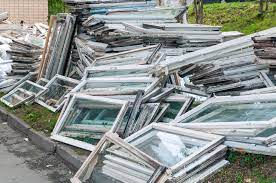Windows plays a pivotal role in our homes, offering natural light, ventilation, and aesthetic appeal. However, as we evolve towards more sustainable living practices, the disposal of old windows becomes a critical consideration. In this article, we explore the world of window recycling, shedding light on the environmental impact of traditional disposal methods and presenting sustainable alternatives.
The Challenge of Window Disposal:
Traditional window disposal methods often involve sending old windows to landfills, contributing to the growing issue of e-waste. Windows, composed of various materials such as glass, metal, and sometimes PVC or wood, can take centuries to decompose. This not only consumes valuable landfill space but also releases harmful chemicals into the environment during decomposition.
Glass Recycling:
Glass, a prominent component of windows, is highly recyclable. Window glass can be transformed into new glass products without losing its quality. Glass recycling not only conserves resources but also reduces energy consumption compared to manufacturing new glass. It’s crucial to separate glass from other materials during disposal to facilitate the recycling process.
Metal Frame Recycling:
Many windows have metal frames, commonly made of aluminum or steel. Metal recycling is an energy-efficient process that significantly reduces greenhouse gas emissions compared to primary metal production. By recycling metal window frames, we can conserve resources and minimize the environmental impact associated with mining and processing raw materials.
PVC and Wooden Window Recycling:
PVC (polyvinyl chloride) and wooden window frames pose a recycling challenge due to their composite nature. However, advancements in recycling technologies are making it possible to recycle these materials. PVC can be recycled into new products, and wooden frames can often be repurposed or transformed into wood chips for various applications.
Donation and Reuse Programs:
An alternative to recycling is donating windows that are still in good condition. Many charitable organizations and reuse programs accept old windows, refurbish them, and provide them to low-income families or for use in community projects. This approach not only reduces waste but also promotes social responsibility and community building.
Upcycling and Repurposing:
Creative individuals and artisans often find innovative ways to upcycle old windows into functional or decorative items. From turning window frames into picture frames to crafting garden trellises or room dividers, the possibilities are endless. Upcycling not only reduces waste but also adds a unique touch to interior and exterior design.
Government Initiatives and Regulations:
Governments worldwide are increasingly recognizing the importance of waste reduction and recycling. Many regions have implemented regulations and incentives to encourage proper disposal and recycling of construction materials, including windows. Familiarizing oneself with local regulations and participating in recycling programs is a proactive step toward environmental responsibility.
Consumer Awareness and Responsibility:
The shift towards sustainable living requires increased awareness and responsibility among consumers. By choosing energy-efficient windows with recyclable materials during new installations, individuals contribute to the demand for eco-friendly practices in the construction industry. Additionally, being informed about local recycling options ensures proper disposal of old windows.
Conclusion:
Window recycling is a crucial component of sustainable living and environmental conservation. By embracing recycling, upcycling, and responsible disposal practices, we can significantly reduce the ecological footprint of our homes and communities. Through individual actions, community initiatives, and support for recycling programs, we pave the way for a future where windows not only enhance our living spaces but also contribute to a healthier planet.

